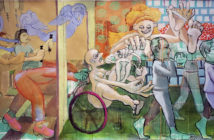The hot topic in the art blogs for the past few days has been collector Eli Broad's decision to retain control of his vast and coveted art collection. It was widely expected that he would donate the body of work to the Los Angeles County Museum of Art (LACMA) and it is considered a humiliation for that museum after their long history of courting Mr. Broad.
In the New York Times, Edward Wyatt points out:
Long assumed to be at the top of the list of potential recipients was the Los Angeles County Museum of Art, which next month is to open the $56 million Broad Contemporary Art Museum, a building designed by Renzo Piano and financed by Mr. Broad, as the centerpiece of its redesigned campus on Wilshire Boulevard.
Coming on the eve of the opening, the decision is a potential embarrassment for the Los Angeles museum. It was widely criticized in 2001 for mounting a major exhibition of works from Mr. Broad’s collection without having secured a promised gift of the works, an act that is prohibited at many prominent art institutions because it can increase the market value of the collection.
The decision also has far-reaching implications for the way museums interact with big donors. In recent years a dizzying rise in art prices and an abiding institutional thirst for acquisitions have given well-heeled donors more influence over what a museum buys and puts on its walls.
On his blog, Edward Winkleman sums up several key problems with the decision, the most notable being:
What does this mean for artists? Well, essentially it means that the ultimate prize may no longer be getting your work into a museum, but rather into a high-profile collection (i.e., so that it will be exhibited more frequently). The problem with that scenario, as I see it, is that whereas there's public pressure on museums not to deaccession work, there's no such pressure on private collectors. Therefore, there's more risk that one's work will end-up, not being preserved for posterity, but rather dumped at auction when the tides of fashion shift. Museums take a very long view of their holdings. It's hard to say what the long view for a lending foundation might be.
Over at Modern Art Notes, Tyler Green has a pair of posts evaluating the decision. In his first post, he talks with Broad Art Foundation director Joanne Heyler about the implications of this consolidation could mean for the future of the collection:
So if you want to put your collection under one roof, and you want to make the most work available to the broadest possible audience, and if you want to exhibit more art than LACMA can, why not just open the collection to the public as the Broad Art Museum and loan liberally from the collection to institutions around the country?
"The final decision is much further down the line, but that's a possibility," Heyler said. "It is not something that would be on any kind of scale what we're doing at BCAM in terms of physical space. At least in terms of exhibition space -- and probably not that big, period. BCAM is 74,000 square feet. But it's early days."
In his second post, he lists several bullet points to consider when evaluating hte decision. Key among them:
One of the things the Broads could have done was influence Los Angeles philanthropy to follow more of a New York-style model, to support the kinds of institutions that help define a city. And they didn't: They tried something new, something vaguely entrepreneurial. (Yes, the Broads have given lots of money to LACMA, but giving something as personal and destination-creating as an art collection is different.) This will have an impact on young wealthy types in LA as they consider how to be philanthropic.
Overall, I suspect that this decision will have a long-lasting impact on how institutions court major collectors. Here in Boston, the MFA has a long and controversial history of bending over backwards in their efforts to secure donations from major collectors (remember "Things I Love: The Many Collections of William I. Koch"?). Now that the ICA has transitioned into a collecting museum, how will they grow their collection, and which collectors will they court? How can they guarantee that their attentions will produce results?



